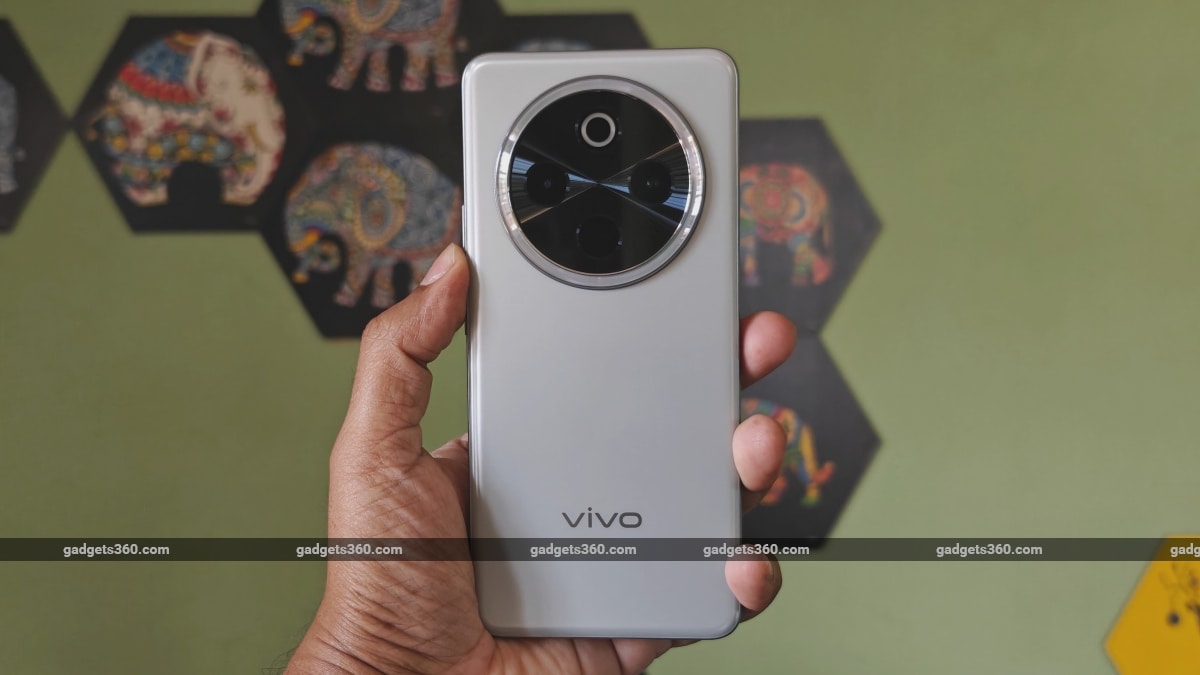Vivo T4 Review: Nearly Perfect

Smartphones at the bottom end of the mid-range segment (starting from Rs. 20,000 and up) are supposed to be the poster boys, enticing and encouraging budget smartphone buyers to spend a bit more with upgrades that need to justify their price tags. The Vivo T4 (also the iQOO Z10) is one such mid-ranger that is expected to offer the typical mid-range glamour wrapped up in an attractive price tag. Sadly, the sub-Rs. 25,000 segment has grown into a very competitive one lately. And Vivo’s T4, despite numerous upgrades, somehow ends up falling a bit short of expectations, even though it may be an ideal choice for some.
Vivo T4 Design
Vivo’s T4 definitely looks the part for a mid-range device. Its overall design is inspired by the ultra-premium Vivo X200 series, but it also has some special design elements, which make it a very attractive smartphone for its price tag.
![]()
The Vivo T4’s curved mid-frame compliments its quad-curved display, giving it a slim overall appearance
At just 199 grams, the phone measures just 7.9mm at its thinnest point. Add to this the aggressively curved polycarbonate mid-frame, the quad-curved display and the quad-curved polycarbonate rear panel, and you will have a phone that also appears very slim.
This is impressive because this smartphone somehow manages to squeeze in a battery with a 7,300mAh capacity. And it’s not just about good looks, as this Vivo smartphone also boasts an IP65-rated design for dust and water resistance.
![]()
The plastic rear panel is a smudge magnet despite its matte finish, but these were hard to spot given our review unit’s nearly white, Phantom Grey finish
Stylish looks aside, I also like that the large rear camera module has a nice plastic ring around it. It won’t scrape a wooden table or your finger when you use it for support.
Vivo T4 Performance
Quad-curved panels give smartphones a stylish and modern appearance, but they also show distracting reflections when viewed outdoors. The Vivo T4’s display is no exception. However, given its price, it’s nice to see that this full-HD+ AMOLED panel is HDR10-certified, which also means it can get really bright (5,000 nits peak) when used outdoors.
![]()
The Vivo T4 has quad-curved, 120Hz AMOLED panel
Sadly, this vibrant display is accompanied by a single, bottom-firing speaker. It’s sufficiently loud and produces a very treble-heavy sound at max (100 percent) volume, but it also sounds a bit distorted. Funtouch OS adds an Audio Booster mode (up to 200 percent), but it’s not much louder compared to 100 percent. There are smartphones both at and above this price point that offer much better (or richer) sound quality.
Based on Android 15, the software is typically Vivo. There are plenty of customisation options, and Vivo has added some practical and handy AI tools to the mix. During the testing period, the phone ran smoothly with no noticeable hiccups and no hint of lag. The same can be said about the fingerprint scanner, which unlocked quickly and worked reliably every single time.
![]()
Vivo’s Funtouch OS 15 is based on Android 15
Results from our benchmark tests are similar to what competing smartphones at this price point have achieved. The Vivo T4 is no different, as can be seen from the benchmark chart below, and just like the others it faces some serious competition from Poco F6, the only phone to offer a Snapdragon 8s Gen 3 SoC at this price point.
| Benchmarks | Vivo T4 | Nothing Phone 3a | Poco F6 |
|---|---|---|---|
| Chipset | Snapdragon 7s Gen 3 (4nm) | Snapdragon 7s Gen 3 (4nm) | Snapdragon 8s Gen 3 (4nm) |
| Display resolution | FHD+ | FHD+ | 1.5K |
| AnTuTu v10 | 7,80,665 | 8,04,179 | 14,57,491 |
| PCMark Work 3.0 | 11,328 | 13,554 | 15,743 |
| Geekbench 6 Single | 1,120 | 1,158 | 1,835 |
| Geekbench 6 Multi | 3,043 | 3,255 | 4,693 |
| GFXB T-rex | 109 | 60 | 120 |
| GFXB Manhattan 3.1 | 51 | 55 | 112 |
| GFXB Car Chase | 28 | 28 | 71 |
| 3DM Slingshot Extreme OpenGL | 5,307 | 5,485 | 5,481 |
| 3DM Slingshot | 6,767 | 6,954 | 4,655 |
| 3DM Wild Life | 3,924 | 3,988 | Maxed Out |
| 3DM Wild Life Unlimited | 4,090 | 4,175 | 11,734 |
Benchmark tests are purely synthetic, and so, they aren’t real-world tests of raw performance. But gaming is.
I tried out Call of Duty: Mobile (CODM) since this is a low-end mid-range device. The phone surprisingly defaulted to Very High graphics and Max frame rates with most of the effects turned off. The game worked smoothly at default settings. Frame rates were not stable, but the gameplay was smooth enough, and I could keep playing for more than 45 minutes at a stretch without any heating issues. I tried running the game at an Ultra frame rate. While the gameplay was visibly smoother, it was not 90 fps smooth.
![]()
The Vivo T4 has only one user-accessible rear-facing camera
While the phone looks good, looks can be deceiving. A clear case for this is the rear camera setup, which is both chunky land large and appears to have 3 rear-facing cameras. However, there’s only one user-accessible 50-megapixel camera.
Vivo T4 primary camera samples (tap images to expand)
Photos captured using the main camera showed slightly saturated colours by default. You can turn down the saturation levels by activating the camera app’s Natural Colour mode, but these may appear a bit too bland and are not really an actual representation of the scene in front of you.
Dynamic range is pretty good, and you get plenty of detail in the bright spots and the shadows, even though the camera tends to overexpose scenes a bit. While photos appear sharp on the phone’s display, zooming in a bit reveals slightly unpolished textures on all surfaces. For some reason, they appear a bit smudged. The details are a bit soft overall unless the object you are shooting is at arm’s length. The phone’s autofocus system is quick to lock focus, and rarely did I come across a scene where I had to tap to focus on an object I wanted it to.
Vivo T4 primary camera samples (tap images to expand)
In low light, the camera captures quality images with good detail. For some reason, the smudgy textures I noticed during daylight shooting are taken care of by the Night mode, and so we have some vibrant photos with good dynamic range and resolved detail. The camera takes a while to shoot low-light photos. In dimly lit scenes, you might have to patiently wait up to 2 seconds or more for an image to be captured.
Vivo T4 2X zoom camera samples (tap images to expand)
Vivo uses a crop of the primary camera’s sensor to zoom in. In Auto mode, the results aren’t good, and you end up with smudged-up textures when shooting anything beyond arm’s length. Basically, it’s not good for shooting photos on your next vacation.
The phone’s Portrait mode does not do well either, but it is tolerable in daylight, as can be seen in the samples below.
Photos captured at 1X show good detail but come out a bit overexposed (tap image to expand)
At 1.5X, the quality deteriorates a bit, and you will start noticing noise and random blotchy textures (tap image to expand)
At 2X, ideal for telephoto shots, the quality of the photos deteriorates even further, and you will also notice some chroma noise settling in.
In low light, things take an expected turn for the worst, with the camera attempting to boost colours and reduce noise, resulting in flat-looking photos of subjects with little resolved detail or texture. (Tap image to expand)
Selfies come out just fine in daylight with good edge detection, but the camera tends to beautify an image when the screen flash is turned on for some weird reason. (Tap image to expand)
Video recording does surprisingly well in daylight, showcasing natural colours and good dynamic range. 1080p 60 fps video recordings have a steady framerate, but the 4K 30 fps video recordings offer the best quality. In low light, colours come out a bit pale, but the video recordings have a steady frame rate. The noise is controlled, so the output looks pretty good.
![]()
The Vivo T4’s high-capacity silicon carbon battery can easily last two days with light usage
One of the highlight features of this smartphone at this price point is its battery capacity. The 7,300mAh battery lasted a very impressive 37 hours and 55 minutes in our HD video loop test, which plays a locally stored video on a loop till the battery runs out. In the PCMark Work Battery test, which runs a bunch of real-world tasks on a loop, the phone impressed once again, managing an impressive score of 26 hours and 56 minutes. Given my daily usage (gaming, camera, social media, calls, office apps), the high-capacity silicon carbon battery got me about 13 hours of screen-on time, which is basically good for two work days of usage. Indeed, depleting this phone’s battery was a proper challenge.
Vivo T4 Verdict
The Vivo T4, priced from Rs. 21,999, is sorted when it comes to battery life and everything else but shows up to the party with one rear camera when we have devices like Nothing’s Phone 3a (Review) offering 3 rear cameras at a slightly higher asking price of Rs. 24,999. It is indeed a bit too hard to settle for a single rear camera at and around this price point. But Vivo offers a capable one, provided you use it at its native (1x) focal length. And if you can live with that, you will get incredible value for your money with the Vivo.
The Poco F6 (Review) continues to remain the choice of gamers given its Snapdragon 8s Gen 3 SoC, which is a steal given the phone’s Rs. 21,999 price tag. And if you can stretch your budget by a few thousand, the OnePlus Nord 4 (Review) is the phone to get, starting from Rs. 27,499.
Vivo could have played its cards better by equipping its T4 with a telephoto camera and reducing the capacity of its battery to make it more enticing for its customers. Given its current hardware, it’s still a good choice for those looking for a slim and stylish mid-range smartphone with incredible battery life.






